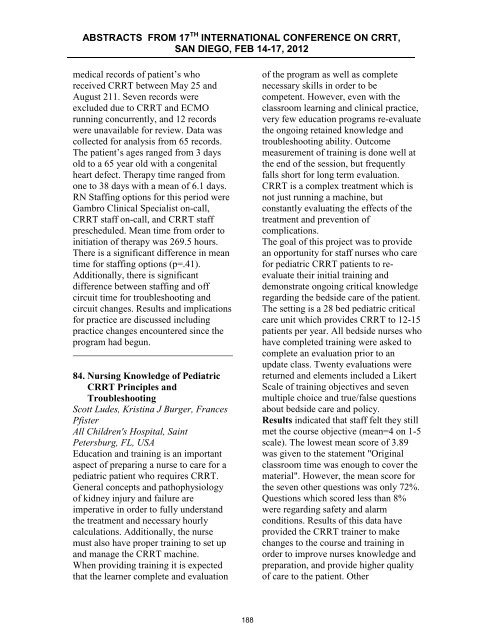ABSTRACTS from 16th International COnference on ... - CRRT Online
ABSTRACTS from 16th International COnference on ... - CRRT Online
ABSTRACTS from 16th International COnference on ... - CRRT Online
You also want an ePaper? Increase the reach of your titles
YUMPU automatically turns print PDFs into web optimized ePapers that Google loves.
<str<strong>on</strong>g>ABSTRACTS</str<strong>on</strong>g> FROM 17 TH INTERNATIONAL CONFERENCE ON <strong>CRRT</strong>,<br />
SAN DIEGO, FEB 14-17, 2012<br />
medical records of patient’s who<br />
received <strong>CRRT</strong> between May 25 and<br />
August 211. Seven records were<br />
excluded due to <strong>CRRT</strong> and ECMO<br />
running c<strong>on</strong>currently, and 12 records<br />
were unavailable for review. Data was<br />
collected for analysis <str<strong>on</strong>g>from</str<strong>on</strong>g> 65 records.<br />
The patient’s ages ranged <str<strong>on</strong>g>from</str<strong>on</strong>g> 3 days<br />
old to a 65 year old with a c<strong>on</strong>genital<br />
heart defect. Therapy time ranged <str<strong>on</strong>g>from</str<strong>on</strong>g><br />
<strong>on</strong>e to 38 days with a mean of 6.1 days.<br />
RN Staffing opti<strong>on</strong>s for this period were<br />
Gambro Clinical Specialist <strong>on</strong>-call,<br />
<strong>CRRT</strong> staff <strong>on</strong>-call, and <strong>CRRT</strong> staff<br />
prescheduled. Mean time <str<strong>on</strong>g>from</str<strong>on</strong>g> order to<br />
initiati<strong>on</strong> of therapy was 269.5 hours.<br />
There is a significant difference in mean<br />
time for staffing opti<strong>on</strong>s (p=.41).<br />
Additi<strong>on</strong>ally, there is significant<br />
difference between staffing and off<br />
circuit time for troubleshooting and<br />
circuit changes. Results and implicati<strong>on</strong>s<br />
for practice are discussed including<br />
practice changes encountered since the<br />
program had begun.<br />
84. Nursing Knowledge of Pediatric<br />
<strong>CRRT</strong> Principles and<br />
Troubleshooting<br />
Scott Ludes, Kristina J Burger, Frances<br />
Pfister<br />
All Children's Hospital, Saint<br />
Petersburg, FL, USA<br />
Educati<strong>on</strong> and training is an important<br />
aspect of preparing a nurse to care for a<br />
pediatric patient who requires <strong>CRRT</strong>.<br />
General c<strong>on</strong>cepts and pathophysiology<br />
of kidney injury and failure are<br />
imperative in order to fully understand<br />
the treatment and necessary hourly<br />
calculati<strong>on</strong>s. Additi<strong>on</strong>ally, the nurse<br />
must also have proper training to set up<br />
and manage the <strong>CRRT</strong> machine.<br />
When providing training it is expected<br />
that the learner complete and evaluati<strong>on</strong><br />
of the program as well as complete<br />
necessary skills in order to be<br />
competent. However, even with the<br />
classroom learning and clinical practice,<br />
very few educati<strong>on</strong> programs re-evaluate<br />
the <strong>on</strong>going retained knowledge and<br />
troubleshooting ability. Outcome<br />
measurement of training is d<strong>on</strong>e well at<br />
the end of the sessi<strong>on</strong>, but frequently<br />
falls short for l<strong>on</strong>g term evaluati<strong>on</strong>.<br />
<strong>CRRT</strong> is a complex treatment which is<br />
not just running a machine, but<br />
c<strong>on</strong>stantly evaluating the effects of the<br />
treatment and preventi<strong>on</strong> of<br />
complicati<strong>on</strong>s.<br />
The goal of this project was to provide<br />
an opportunity for staff nurses who care<br />
for pediatric <strong>CRRT</strong> patients to reevaluate<br />
their initial training and<br />
dem<strong>on</strong>strate <strong>on</strong>going critical knowledge<br />
regarding the bedside care of the patient.<br />
The setting is a 28 bed pediatric critical<br />
care unit which provides <strong>CRRT</strong> to 12-15<br />
patients per year. All bedside nurses who<br />
have completed training were asked to<br />
complete an evaluati<strong>on</strong> prior to an<br />
update class. Twenty evaluati<strong>on</strong>s were<br />
returned and elements included a Likert<br />
Scale of training objectives and seven<br />
multiple choice and true/false questi<strong>on</strong>s<br />
about bedside care and policy.<br />
Results indicated that staff felt they still<br />
met the course objective (mean=4 <strong>on</strong> 1-5<br />
scale). The lowest mean score of 3.89<br />
was given to the statement "Original<br />
classroom time was enough to cover the<br />
material". However, the mean score for<br />
the seven other questi<strong>on</strong>s was <strong>on</strong>ly 72%.<br />
Questi<strong>on</strong>s which scored less than 8%<br />
were regarding safety and alarm<br />
c<strong>on</strong>diti<strong>on</strong>s. Results of this data have<br />
provided the <strong>CRRT</strong> trainer to make<br />
changes to the course and training in<br />
order to improve nurses knowledge and<br />
preparati<strong>on</strong>, and provide higher quality<br />
of care to the patient. Other<br />
188
















